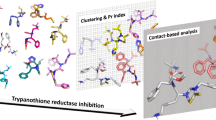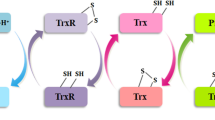Abstract.
A theoretical docking study on the active sites of trypanothione reductase (TR) and glutathione reductase (GR) with the corresponding natural substrates, trypanothione disulfide (T[S]2) and glutathione disulfide (GSSG), is reported. Molecular dynamics simulations were carried out in order to check the robustness of the docking results. The energetic results are in agreement with previous experimental findings and show the crossed complexes have lower stabilization energies than the natural ones. To test DOCK3.5, four nitro furanic compounds, previously designed as potentially active anti-chagasic molecules, were docked at the GR and TR active sites with the DOCK3.5 procedure. A good correlation was found between differential inhibitory activity and relative interaction energy (affinity). The results provide a validation test for the use of DOCK3.5 in connection with the design of anti-chagasic drugs.
Similar content being viewed by others
Author information
Authors and Affiliations
Additional information
Received: 9 January 2002 / Accepted: 3 April 2002 / Published online: 22 May 2002
Rights and permissions
About this article
Cite this article
Iribarne, F., Paulino, M., Aguilera, S. et al. Docking and molecular dynamics studies at trypanothione reductase and glutathione reductase active sites. J Mol Model 8, 173–183 (2002). https://doi.org/10.1007/s00894-002-0082-0
Issue Date:
DOI: https://doi.org/10.1007/s00894-002-0082-0




